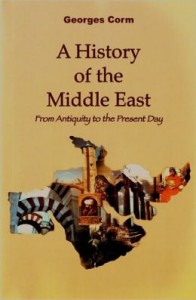|
Reviewed by Nicholas Di Liberto, Ph.D., Assistant Professor of History and Humanities, Newberry College The Franco-Lebanese economic historian Georges Corm’s synoptic work, Histoire du Moyen-Orient (Paris, 2007), now translated into English, offers what the author calls a “profane history of the Middle East.” The “profane,” for Corm, is identical to the “strictly political,” which the author understands broadly to include the “geographic and linguistic benchmarks” (180) that best unravel this “land of obscure complexity.” Although we are treated to a promising introductory discussion of the physical geography of the lands from the Libyo-Egyptian desert to the Elbruz Mountain Ranges in Northern Iran, Corm does little to sustain these environmental insights in the largely political narrative that follows. Corm continually refers to Greco-Hellenism as the basis for the region’s rich “cultural geology.” The author focuses on the accomplishments of Hellenism and other “Pagan” influences as a counterweight to Islamic and monotheistic cultures that tend to be the protagonists in traditional histories.Yet Corm’s history “in the profane mode” is less strictly a secular narrative of the Middle East than it is an account of the regressive role of monotheistic religions. Determined to prove the deleterious effects of monotheism, Corm often spends more time on events such as the Crusades, overstates their importance, and inadvertently reproduces the clash of civilizations/monotheisms perspective he wants to challenge. Corm is certainly right to criticize contemporary scholarship and “official histories” for simplifying the cultural diversity of the Middle East by viewing it in terms of the rise and struggle of the great monotheisms. However, Corm’s account sometimes devolves into the same kind of simplifications. For example, he uncritically lauds Greco-Roman Hellenism and “Babylonian paganism” as underappreciated sources of structural stability in lands so culturally diverse. The cultural tolerance of the Persian Empire is hardly mentioned. The Zoroastrian faith of the Persians would have been more difficult to assimilate into Corm’s dualistic view of profane pagan tolerance versus monotheistic fanaticism. In contrast to the overstated importance of the Crusades, Corm trivializes the more devastating Mogol invasions and offers the “Mongol Peace” as “the last episode of religious syncretism and religious tolerance in the Middle Ages” (76-77). Finally, omitting details of early Judaic history might be acceptable in a brief survey; however, simply suggesting without apparent irony that “[a] historical description of the tribes of Israel can be found in the Bible” (53) would seem to open Corm to the charge that he denies Hebraic history the same “profane” complexity that he accords Islamic civilizations. Corm’s treatment of the modern Middle East in Part II is better organized and more helpful. He provides a perceptive account of the varied political and religious responses to the influx of Western cultural values and social relations during the period of Franco-British imperialism. Corm contrasts Egyptian religious-liberal and later Turkish secular nationalism with the Islamicist movements that characterized Saudi Arabia and later Iran. Whereas Saudi power has been disproportionately propped up by oil revenues from the very foreign nations its Wahabbi supporters abhor, the promising chances of liberal democratic movements in Egypt were consistently frustrated by Cold War power politics that supported “reliable” military dictatorships. As a Lebanese scholar, Corm has a greater appreciation for the neglected minorities—Armenians, Kurds, Copts, Druze, etc.—who have so often found themselves in the crossfire of the conflicts of larger, artificial “nation states” formed after the period of Franco-British mandates. Clearly anti-Zionist, Corm does not unequivocally support the cause of the Palestinian leadership, or its external, fair-weather supporters in the Muslim world. Corm offers a devastating case for the way in which foreign Islamic movements have used the Palestinian cause for their own political advantage, and for how Lebanon has been the surrogate battleground for the Israeli-Arab game of brinkmanship. Corm’s excellence as an economic historian shows in his ability to explain the underlying economic causes and effects of political conflicts. He would better serve the general reader by focusing in on how crass economic and political concerns serve to radicalize and instrumentalize religious conviction. Rather than simplifying the boundary between the political and the religious, Corm should be more careful to disentangle the modern conflation of religion and politics from the long-term historical narrative. Otherwise, he simply reproduces the asymmetrical oppositions between “Oriental Religious Despotism” and “Western Secular Democracy” that the author ably, but too briefly dissects in the book’s final sections. Corm delivers a unique perspective on modern politics in Southwest Asia that has much to offer both students and general readers, who possess enough background knowledge to understand the book’s limitations. |


 A History of the Middle East: From Antiquity to the Present Day
A History of the Middle East: From Antiquity to the Present Day